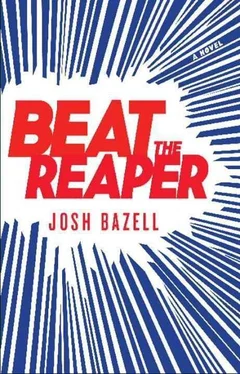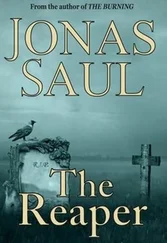Skinflick and I had barely spoken to each other since the shooting began. We were both deeply shaken, but we also both knew that Skinflick’s decision to cap a wounded fourteen-year-old was enough to destroy our friendship, and would have been even on a day when nothing else went wrong.
And two weeks later I was arrested for the murder of Les Karcher’s two wives.
The instruments nurse gives me a tiny-headed scalpel. I pull it lightly down the center of the newly inked line on Squillante’s abdomen, causing the ink, iodine wrap, and skin to spring apart about an inch. For a second, before the cut fills with blood, its fatty walls look like cottage cheese. Then I hand the scalpel back. It won’t be used again this operation. Scalpels cut cleanly, but they can’t stop bleeding.
Friendly says “Clamp.”
I say “Bovie and suction.”
A “Bovie” is an electrocautery, a device shaped like a pen with a cord coming out the back and strip of metal extending from the tip. It looks like a tiny cattle prod, so it’s unfortunate that “Bovie” is the name of its inventor, and not short for “bovine.”
A Bovie not only cuts but also burns, so it closes blood vessels as you go. (It also leaves a trail of ugly carbonized flesh, which is why you don’t use it to cut skin.) The idea is to suction the blood out of the incision, then quickly spot the cut ends of the arteries and use the Bovie to fry them shut. You have to do it fast, because suctioning only gives you a split second of visibility. Then it’s all just blood again.
I hand the suction to my student, who won’t look as stupid overusing it. Every time the student sucks the blood out, I wait until the tiny dots of blood appear, then pick one and try to electrocute it before it goes back to spurting.
At this rate the operation will take several days, and on top of that my periods of consciousness and unconsciousness are starting to alternate, lasting a thousandth of a second each, like the peaks and troughs of a radio signal. Sweat drips off my forehead into Squillante’s incision.
Eventually Friendly gets bored and starts poking around with his “clamp,” which looks like a pair of needle-nosed pliers. He grabs at arteries I can’t see, so that all I have to do is touch the Bovie to the metal of his instrument and fry the arteries by conduction, on faith.
When the bleeding’s stopped, Friendly jabs down into the gunky membrane at the bottom of the incision and spreads the jaws of his clamp, tearing the membrane apart. Then he picks out some more vessels for me to burn.
As he does so, Friendly looks at the instruments nurse, who’s a black man in his twenties. “So I can’t say ‘gay’ in the OR,” Friendly says. “Too many fragile people in here. I need to ask permission first. I forget the whole thing’s collaborative now.”
The instruments nurse doesn’t respond, so Friendly turns to my med student. “You know what ‘collaborative medicine’ means?” he says.
“No, sir,” the student says.
“It means an extra ten hours of unpaid bullshit a week. Look forward to it, kiddo.”
“Yes, sir,” the student says.
Friendly turns back to the instruments nurse. “Can I say ‘black’ in here? Or do I have to say something else?” He pauses. “How about ‘the artists formerly known as Negroes’? Can I say that? Or do I need to ask permission to say that, too?”
Operating rooms, I should say, along with construction sites, are the last safe havens for sexists, racists, or anyone else with a Tourette’s-like condition. The idea is that harassing people teaches them to stay calm under pressure. The reality is that sociologists could study ORs to learn what workplaces were like in the 1950s.
“What do you say, Scott?” Dr. Friendly says to the instruments nurse.
The instruments nurse looks up at him coolly. “Are you talking to me, Dr. Friendly?”
“If I am, I have no idea why,” Friendly says. He tosses his bloody clamp right into the middle of the instruments tray. “That’s it. Let’s open up.” He digs his fingertips into the incision, then leans over and tugs it wide like an enormous leather change purse. You can see Squillante’s beet-red abdominal muscles, which have a bright white stripe down the middle where we’ll make the next incision, because this stripe has almost no blood supply.
“Sister Mary Joseph negative,” Friendly calls out to the circulating nurse, who’s now at the computer. “There’s also no Virchow’s node, though you’ll have to take my word for it.” [42] Cancer talk!
I Bovie along the white stripe.
“Will you be using Japanese or American lymph-node guidelines?” my med student asks.
“That depends,” Friendly says. “Are we in Japan?”
“Sir, what’s the difference?” my other student asks, from the floor.
“In Japan they spend all day hunting down nodes for preventative resection,” Friendly says. “Because in Japan they have socialized healthcare.” He pulls the twin bands of muscle apart. “Retractor,” he says. “We’re in the abdomen.”
The instruments nurse starts assembling the retractor, which is a large hoop that can be locked into place to hold the incision open.
While we wait, Friendly looks back at the student who’s not scrubbed in. “Don’t worry, we’ll get the socialized stuff over here soon enough,” he says. “Stacey. You want to check my beeper?”
“Sure, Dr. Friendly,” Stacey says. “Where is it?”
“In my pants.”
Suddenly there are a lot of downturned eyes in the room. Stacey gamely walks over and pats Friendly’s ass.
“Front pocket,” he says.
As I think I’ve mentioned elsewhere, scrub pants and shirts are reversible. So that while the back pants pocket is on the right, outside your pants, the front one’s on the left, inside your pants.
Stacey reaches under Friendly’s surgical gown and roots around his crotch. She wrinkles her nose at me while she’s doing it, in a way that’s actually fairly winning.
“There’s nothing there,” she finally says.
“We already knew that, ” the scrub nurse says.
Everyone laughs uproariously. Friendly turns red, then blotchy, above his mask. He grabs the retractor out of the instruments nurse’s hands and wedges it roughly into Squillante’s abdomen.
“You know what?” he says when it’s in place. “Fuck all of you. Let’s get to work.”
We do. For a while, all you can hear is the beeping of Squillante’s EKG. To me, each beep feels like an alarm clock after an eternity of restless sleep. My Assman-injected forearm is starting to twitch.
But we’re making progress, at least. First we pile through Squillante’s intestines, each loop of which is anchored to a thin sheet of tissue that supplies it with blood and so on. So that while they can slide all over each other, like sharks in a tank, you can’t just unspool them like a rope. You have to leaf through them, like the pages of a Rolodex, or a phone book.
“Give me some reverse Trendelenburg,” Friendly says. [43] “Reverse Trendelenburg” means the patient’s feet are lower than his head. “Trendelenburg” means his feet are higher than his head. No surgeon on earth would be caught dead saying “head up” or “head down,” though. In case you’re wondering why your appendectomy took four hours.
The reverse Trendelenburgness helps us finish folding the intestines out of the way, and at last reveal Squillante’s stomach.
As with the initial incision, the complexity here will not be in removing the stomach, since any Aztec priest could take out five of them and be on the links by noon. The difficulty will be in controlling the bleeding—finding and cutting off the dozens of arteries that enter the stomach like the spokes of a wheel—so that Squillante doesn’t die. Friendly picks up a second Bovie and starts picking out arteries on his side as I work on mine.
Читать дальше










